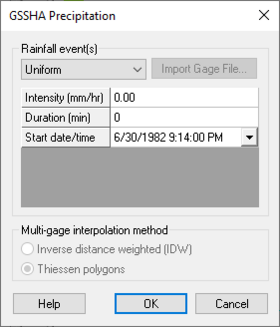WMS:GSSHA Precipitation
Rainfall can be input in one of the following formats:
- Uniform constant rainfall over the entire watershed.
- Single temporally varying rain gage.
- Multiple temporally varying rain gages.
- User defined hyetograph.
- NEXRAD radar data.
All rainfall types in GSSHA must be tied to a specific point in time by specifying the year, month, day, hour, and minute of each rainfall data point. The GSSHA Precipitation dialog in WMS allows specifying the type of rainfall and enter the necessary data associated with the rainfall type. The GSSHA Precipitation dialog is accessed from the GSSHA menu in the 2D grid module.
Uniform Rainfall
The ability to assign uniform rainfall over the entire watershed is maintained largely as a trouble-shooting feature and is mostly used in initial model development. Real watersheds are modeled with temporally and spatially varying rainfall. For spatially and temporally constant rainfall, the input parameters are:
- Rainfall Intensity (mm/hr)
- Rainfall Duration (minutes)
- Start Time
- Year
- Month
- Day
- Hour
- Minute
Gage Rainfall
Select the Gage option to specify single or multi-gage rainfall. Rainfall distributions for all rain gages should already be entered on a rain gage coverage in WMS. Create a separate rain gage coverage for each precipitation event. Rain gage files constructed using an editor outside of WMS can be used in two ways: reference the file in the Manage Files dialog when saving the GSSHA project file or use the Import Gage File... button to read the file and generate rain gage coverages in WMS.
Temporally Varying, Spatially Uniform (Single Gage) Rainfall
Single-gage rainfall produces a time series of rainfall for the entire watershed. Toggle on the the rain gage coverages (containing a single gage) in the dialog that will be used for writing the GAG file required by GSSHA.
Temporally Varying Multiple-Gage Rainfall
Select rain gage coverages with multiple gages defined to be used for writing the GAG file required by GSSHA. Specify whether to use Inverse distance weighting (IDW) or Thiessen polygons for determining the spatial variation in rainfall for each grid cell.
Hyetograph
Select the Hyetograph option to enter a temporally varying, spatially uniform (single-gage) event without creating a rain gage coverage. Enter the average total depth (mm) of precipitation across the drainage area and the start date/time. Click on the Define Distribution... button to define the temporal distribution.
NEXRAD
Select the Nexrad Radar option and click on the Import Radar Data... button to process NEXRAD rainfall data for use in GSSHA. WMS will write the GSSHA rainfall (*.gag) file using the RADAR type. For RADAR type rainfall inputs, Thiessen polygons should be selected as the interpolation method.
Related Topics
GSSHA | |
|---|---|
| XMS Wiki Links | Calibration (Automated • Manual • Output) • Channel Routing • Contaminants • Digital Dams • Embankment Arcs • Feature Objects (Arcs • Nodes • Polygons) • File Types • Groundwater • Groups • Hydraulic Structures • Job Control • Join SSURGO Data • Mapping Tables • Maps • Menu • Model Linkage • Multiple Simulations • Nutrients • Observations • Output Control • Overland Soil Erosion • Pipe and Node Parameters • Precipitation • Radar Rainfall • Save GSSHA Project File • Smooth GSSHA Streams • Snowmelt • Solution (Analysis • Data) |
| Related Tools | MWBM Wizard • Using Soil Type Data with GSSHA |
| GSSHA Wiki External Links | GSSHA Wiki: Overview • Primer • User's Manual • Tutorials |
